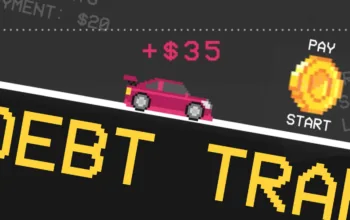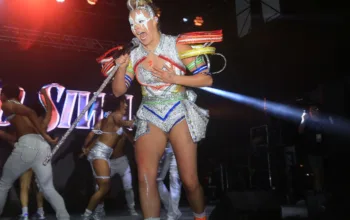How frantic, meaningless videos took over the internet.
Last week, people were very confused about a TikTok advertisement that appeared to be from Amazon. I’ll try to explain it, but really the only way to understand what I’m talking about is to experience the video for yourself: Basically, there are a bunch of clips from the gaming platform Roblox set to two text-to-speech AIs that just roast each other back and forth, and at every punchline it cuts to a grainy video of someone listening to Flo Rida’s “Low.”
The so-called ad wasn’t confusing because it was bad — it was confusing because it was actually really good, at least according to a large portion of the internet.
this was an amazon ad I got on tik tok???
this is 100% real I just recorded it pic.twitter.com/cST0JoKb33
— Eddy Burback (@eddyburback) August 4, 2021
You may have seen similar content circulating social media: Video of marine life against audio of gunshot sounds and the theme from Titanic, spliced together with PowerPoint transitions. A slideshow of mildly cursed images set to Aphex Twin. A series of clip art images and Jason Bateman headshots that appear to create a horror movie about wanting to have sex with Jason Bateman. An imagined vlog of opening night of Swan Lake, as told by Pyotr Ilyich Tchaikovsky and illustrated by clips of Drag Race and the sounds of Nicki Minaj.
The point of all of them is that they’re not only weird, but frantic. It’s a style of video that can be dubbed the chaos edit, as Vulture coined it in its list of the 25 defining internet videos of the post-YouTube era, and which E. Alex Jung described as “like getting an IV hookup of pure internet chaos.” Chaos edits, by their very nature, can be made up of anything the creator wants, but many share certain stylistic qualities: sped-up audio, intentionally shitty image or sound quality enhanced by watermarks or graininess, and disturbing or gross-out humor.
@willgrahamsdog REPOSTING #fyp #jasonbateman #dilfs #jasonbatemanedit #michaelbluth #martybyrd #arresteddevelopment #foryou
TikTok did not invent the concept of the chaos edit, though it certainly is delivering it to new audiences. The format’s origins lie partially in surrealist cinema, which has existed since cinema has, and borrows from vaporwave, deep fried memes, Weird Twitter, cringe compilations and ironic appropriations of the corny or awful things regular people post on the internet all the time.
They do, however, feel particularly of-the-moment; I’m seeing them a lot more frequently, and this brand of humor recently gained a decent amount of attention when Courtney Love described Gen Z as “funnier than any other generation” and noted that she followed the Instagram account @on_a_downward_spiral, a popular shitposting meme page. On Monday, internet agenda-setter Taylor Lorenz published a piece on these types of bizarre, text-centric Instagram accounts; one 19-year-old meme page admin said that the humor comes from “the dissonance between the photo and the text.”
If you’ve been on the internet long enough, you’ll know that we’ve been writing trend pieces about why the next generation of online young people are really into nihilistic surrealism and meaningless humor forever. (Which, I suppose, I am also doing now.) You can give pretty much any explanation for why these sorts of videos — Ms. Juicy Baby of Little Women: Atlanta doing bicycles at the gym followed by Scarlett Johansson dancing in Marriage Story? Sure! — are popular, and it’ll probably make sense.
Perhaps it’s a pushback against the tyranny of Instagram perfection; perhaps it’s simply the logical endpoint of mass availability of video editing software. Perhaps it’s because chaos alone can encapsulate what a chronically online brain looks and feels like. Or perhaps it’s because everyone is reading Patricia Lockwood and listening to too much hyperpop. In 2017 then-Washington Post columnist Elizabeth Bruenig (another internet agenda-setter, in a different way), posited that “millennial humor” (Winnie the Pooh as a 9/11 truther, the entire saga of Harambe) was so weird because on the whole, our lives were starting to look pretty bleak, and nothing made sense.
/cdn.vox-cdn.com/uploads/chorus_asset/file/22772176/Screen_Shot_2021_08_09_at_4.20.22_PM.png) @on_a_downward_spiral/Instagram
@on_a_downward_spiral/InstagramThat is, obviously, even more true today. The speed with which dizzying amounts of information enters our brains has increased since then, and nobody really knows what it’s doing to us. Captioned one TikTok user in a video attempting to illustrate this state of being: “POV ur my phone watching me watch the saddest video ever made then immediately get shot with serotonin bc this app is psychotic.” The already-chaotic vlogging style popular on YouTube has only gotten more so on its shorter, faster younger sibling (I’m not even going to attempt to describe what’s going on in this day-in-the-life TikTok).
I think there’s a less discussed aspect of why these sorts of videos and memes are popular, and it’s the most boring reason of all: It’s because they’re sort of cool and alt, and when you publicly share a chaos edit or a shitpost, you get to feel superior to other people who might not fully “get it.” One of my favorite recent TikToks is a POV of someone seeing a meme on @on_a_downward_spiral and reposting it on their Instagram story. “I’m literally going to be the most unique bitch,” they say. “My sense of humor is so far-developed.” (@on_a_downward_spiral obviously reposted the TikTok, making the whole thing an ouroboros of self-aware self-awareness.)
Yet as soon as something becomes widespread enough to be given a name (and a mention in the New York Times), it immediately starts to become less cool and alt. Brands have long adopted the dadaist nihilism of Twitter for their own gain; it’s probably only a matter of time before Denny’s makes a chaos edit of someone choking on pancakes set to Charli XCX’s “Unlock It.” For what it’s worth, the weird Amazon ad on TikTok wasn’t real: A TikTok spokesperson told the Verge it was the result of a glitch in which Amazon’s ad was swapped out with a random video. So perhaps the real chaos was the algorithm all along.
This column first published in The Goods newsletter. Sign up here so you don’t miss the next one, plus get newsletter exclusives.
Author: Rebecca Jennings
Read More



